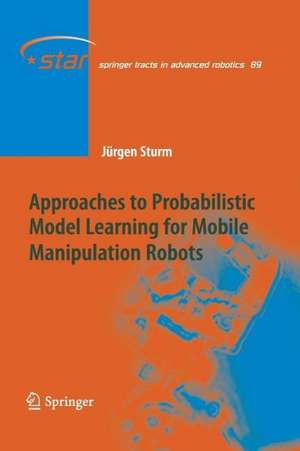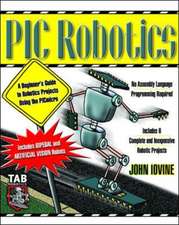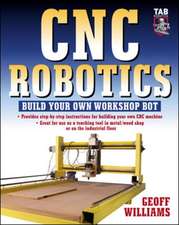Approaches to Probabilistic Model Learning for Mobile Manipulation Robots: Springer Tracts in Advanced Robotics, cartea 89
Autor Jürgen Sturmen Limba Engleză Paperback – 20 iun 2015
Examples include domestic service robots that implement large parts of the housework, and versatile industrial assistants that provide automation, transportation, inspection, and monitoring services. The challenge in these applications is that the robots have to function under changing, real-world conditions, be able to deal with considerable amounts of noise and uncertainty, and operate without the supervision of an expert.
This book presents novel learning techniques that enable mobile manipulation robots, i.e., mobile platforms with one or more robotic manipulators, to autonomously adapt to new or changing situations. The approaches presented in this book cover the following topics: (1) learning the robot's kinematic structure and properties using actuation and visual feedback, (2) learning about articulated objects in the environment in which the robot is operating, (3) using tactile feedback to augment the visual perception, and (4) learning novel manipulation tasks from human demonstrations.
This book is an ideal resource for postgraduates and researchers working in robotics, computer vision, and artificial intelligence who want to get an overview on one of the following subjects:
· kinematic modeling and learning,
· self-calibration and life-long adaptation,
· tactile sensing and tactile object recognition, and
· imitation learning and programming by demonstration.
| Toate formatele și edițiile | Preț | Express |
|---|---|---|
| Paperback (1) | 637.28 lei 6-8 săpt. | |
| Springer Berlin, Heidelberg – 20 iun 2015 | 637.28 lei 6-8 săpt. | |
| Hardback (1) | 642.51 lei 6-8 săpt. | |
| Springer Berlin, Heidelberg – 25 mai 2013 | 642.51 lei 6-8 săpt. |
Din seria Springer Tracts in Advanced Robotics
- 18%
 Preț: 910.26 lei
Preț: 910.26 lei - 18%
 Preț: 893.71 lei
Preț: 893.71 lei -
 Preț: 445.98 lei
Preț: 445.98 lei -
 Preț: 406.44 lei
Preț: 406.44 lei -
 Preț: 523.44 lei
Preț: 523.44 lei - 17%
 Preț: 378.36 lei
Preț: 378.36 lei - 15%
 Preț: 640.88 lei
Preț: 640.88 lei - 18%
 Preț: 783.98 lei
Preț: 783.98 lei - 15%
 Preț: 641.74 lei
Preț: 641.74 lei - 15%
 Preț: 640.88 lei
Preț: 640.88 lei - 18%
 Preț: 994.72 lei
Preț: 994.72 lei - 18%
 Preț: 778.45 lei
Preț: 778.45 lei - 18%
 Preț: 730.35 lei
Preț: 730.35 lei - 18%
 Preț: 1233.83 lei
Preț: 1233.83 lei - 18%
 Preț: 951.47 lei
Preț: 951.47 lei - 15%
 Preț: 640.06 lei
Preț: 640.06 lei - 18%
 Preț: 1844.67 lei
Preț: 1844.67 lei - 15%
 Preț: 642.51 lei
Preț: 642.51 lei - 18%
 Preț: 1112.30 lei
Preț: 1112.30 lei - 15%
 Preț: 665.08 lei
Preț: 665.08 lei - 18%
 Preț: 947.85 lei
Preț: 947.85 lei - 15%
 Preț: 640.88 lei
Preț: 640.88 lei - 18%
 Preț: 776.88 lei
Preț: 776.88 lei - 18%
 Preț: 959.04 lei
Preț: 959.04 lei - 15%
 Preț: 659.02 lei
Preț: 659.02 lei - 15%
 Preț: 654.95 lei
Preț: 654.95 lei - 18%
 Preț: 973.38 lei
Preț: 973.38 lei - 5%
 Preț: 724.70 lei
Preț: 724.70 lei - 18%
 Preț: 981.49 lei
Preț: 981.49 lei - 18%
 Preț: 954.45 lei
Preț: 954.45 lei - 15%
 Preț: 641.53 lei
Preț: 641.53 lei - 15%
 Preț: 653.98 lei
Preț: 653.98 lei - 24%
 Preț: 814.83 lei
Preț: 814.83 lei - 18%
 Preț: 968.65 lei
Preț: 968.65 lei - 18%
 Preț: 970.70 lei
Preț: 970.70 lei
Preț: 637.28 lei
Preț vechi: 749.73 lei
-15% Nou
Puncte Express: 956
Preț estimativ în valută:
121.96€ • 126.86$ • 100.68£
121.96€ • 126.86$ • 100.68£
Carte tipărită la comandă
Livrare economică 14-28 aprilie
Preluare comenzi: 021 569.72.76
Specificații
ISBN-13: 9783642437144
ISBN-10: 3642437141
Pagini: 232
Ilustrații: XXV, 204 p.
Dimensiuni: 155 x 235 x 12 mm
Greutate: 0.33 kg
Ediția:2013
Editura: Springer Berlin, Heidelberg
Colecția Springer
Seria Springer Tracts in Advanced Robotics
Locul publicării:Berlin, Heidelberg, Germany
ISBN-10: 3642437141
Pagini: 232
Ilustrații: XXV, 204 p.
Dimensiuni: 155 x 235 x 12 mm
Greutate: 0.33 kg
Ediția:2013
Editura: Springer Berlin, Heidelberg
Colecția Springer
Seria Springer Tracts in Advanced Robotics
Locul publicării:Berlin, Heidelberg, Germany
Public țintă
ResearchCuprins
Introduction.- Basics.- Body Schema Learning.- Learning Kinematic Models of Articulated Objects.- Vision-based Perception of Articulated Objects.- Object Recognition using Tactile Sensors.- Object State Estimation using Tactile Sensors.- Learning Manipulation Tasks by Demonstration.- Conclusions.
Recenzii
From the reviews:
“This book is convenient for research purposes. It has a clear structure and is fairly readable. The topic may be appropriate for graduate studies.” (Ramon Gonzalez Sanchez, Computing Reviews, January, 2014)
“This book is convenient for research purposes. It has a clear structure and is fairly readable. The topic may be appropriate for graduate studies.” (Ramon Gonzalez Sanchez, Computing Reviews, January, 2014)
Textul de pe ultima copertă
Mobile manipulation robots are envisioned to provide many useful services both in domestic environments as well as in the industrial context.
Examples include domestic service robots that implement large parts of the housework, and versatile industrial assistants that provide automation, transportation, inspection, and monitoring services. The challenge in these applications is that the robots have to function under changing, real-world conditions, be able to deal with considerable amounts of noise and uncertainty, and operate without the supervision of an expert.
This book presents novel learning techniques that enable mobile manipulation robots, i.e., mobile platforms with one or more robotic manipulators, to autonomously adapt to new or changing situations. The approaches presented in this book cover the following topics: (1) learning the robot's kinematic structure and properties using actuation and visual feedback, (2) learning about articulated objects in the environment in which the robot is operating, (3) using tactile feedback to augment the visual perception, and (4) learning novel manipulation tasks from human demonstrations.
This book is an ideal resource for postgraduates and researchers working in robotics, computer vision, and artificial intelligence who want to get an overview on one of the following subjects:
· kinematic modeling and learning,
· self-calibration and life-long adaptation,
· tactile sensing and tactile object recognition, and
· imitation learning and programming by demonstration.
Examples include domestic service robots that implement large parts of the housework, and versatile industrial assistants that provide automation, transportation, inspection, and monitoring services. The challenge in these applications is that the robots have to function under changing, real-world conditions, be able to deal with considerable amounts of noise and uncertainty, and operate without the supervision of an expert.
This book presents novel learning techniques that enable mobile manipulation robots, i.e., mobile platforms with one or more robotic manipulators, to autonomously adapt to new or changing situations. The approaches presented in this book cover the following topics: (1) learning the robot's kinematic structure and properties using actuation and visual feedback, (2) learning about articulated objects in the environment in which the robot is operating, (3) using tactile feedback to augment the visual perception, and (4) learning novel manipulation tasks from human demonstrations.
This book is an ideal resource for postgraduates and researchers working in robotics, computer vision, and artificial intelligence who want to get an overview on one of the following subjects:
· kinematic modeling and learning,
· self-calibration and life-long adaptation,
· tactile sensing and tactile object recognition, and
· imitation learning and programming by demonstration.
Caracteristici
Presents recent research in Probabilistic Model Learning for Mobile Manipulation Robots Presents novel learning techniques that enable mobile manipulation robots, i.e., mobile platforms with one or more robotic manipulators, to autonomously adapt to new or changing situations Describes experiments, which have been conducted to analyze and validate the properties of the developed algorithms








